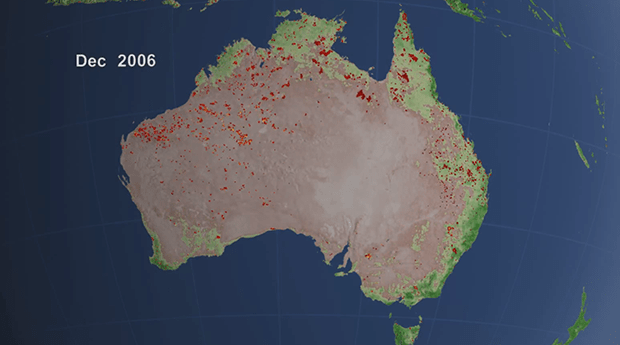History of bushfires in Australia

VIDEO: Historical timeline of bushfires in Australia. (Credit: NASA/Goddard Space Flight Center Scientific Visualization Studio)
AS ANOTHER BUSHFIRE SEASON begins across Australia, it is all too easy to see fire as a dangerous force, something to be avoided at all costs.
But as a recent NASA animation featuring Australian bushfires over the last decade illustrates, fire is a consistent feature of the Australian landscape.
“In all Australian landscapes, fire has an integral role to play in organising vegetation, biodiversity, and other functions of the landscape,” says Professor Ross Bradstock, a fire ecologist who directs the Centre for Environmental Risk Management of Bushfires at the University of Wollongong. “It’s part of the furniture.”
Fire risk reliant on location
The way fire interacts with a landscape—and perhaps more importantly for humans, the probability that a bushfire might occur in a given area—is dependent on a variety of environmental factors.
“The distinction between forests where most people live and the drier country … is incredibly important in understanding fire,” Ross says.
In dry landscapes, like Australia’s central grasslands or northern tropical savannahs, excess rain ushers in extraordinary growth. Patches of typically barren earth fill with herbs and grasses that eventually die back at the end of the rainy season, creating conditions that are ripe for fire.
Bushfires and risk prediction
Wetter regions, including much of the forestland along the eastern coast of Australia and in Tasmania, are prone to bushfire during periods of drought. Only then does the tree and shrub litter that covers the forest floor dry out enough to fuel large-scale bushfires, like those that have devastated South Eastern Australia over the last decade.
“Where we’re sitting at the moment is after a fairly wet year,” Ross says. “A lot of the dry country has had a lot of rain, so what we’re seeing is a potential for big fires,” Ross says. “Ten years ago we had similar conditions across much of central Australia … We had a massive area burnt.” The large-scale fires that devastated central Australia in 1974 were a result of a similarly wet year.
But the amount of dry fuel on the ground is not the only factor that matters when it comes to predicting fire risk.
“There are sort of long term drivers like is it going to be a wet summer or dry summer, but those are really sort of broad categories,” says Justin Leonard, a CSIRO research scientist with expertise in bushfire urban design. “You can still have a really hot, dry week in a really wet summer.”
RELATED STORIES

